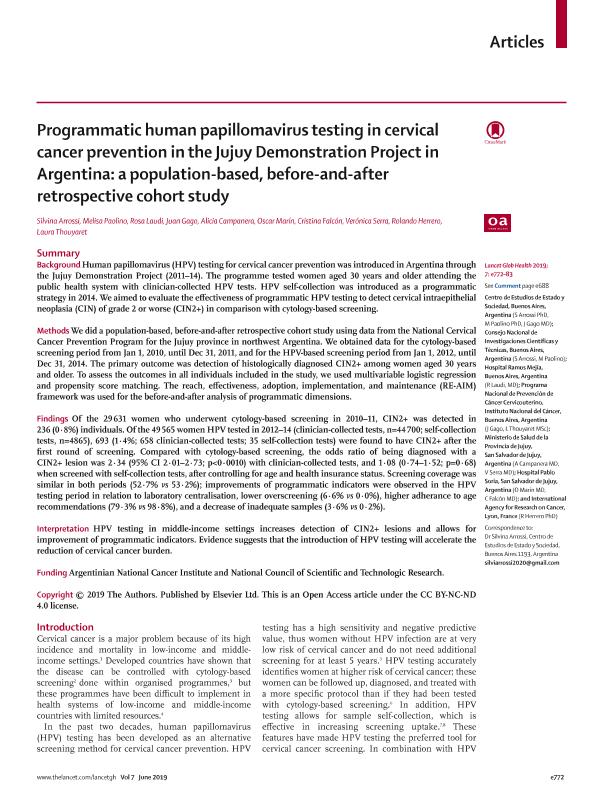Mostrar el registro sencillo del ítem
dc.contributor.author
Arrossi, Silvina

dc.contributor.author
Paolino, Melisa Delia

dc.contributor.author
Laudi, Rosa
dc.contributor.author
Gago, Juan Ezequiel

dc.contributor.author
Campanera, Alicia

dc.contributor.author
Marín, Oscar
dc.contributor.author
Falcón, Cristina
dc.contributor.author
Serra, Verónica
dc.contributor.author
Herrero, Rolando
dc.contributor.author
Thouyaret, Laura

dc.date.available
2021-04-07T12:50:41Z
dc.date.issued
2019-06
dc.identifier.citation
Arrossi, Silvina; Paolino, Melisa Delia; Laudi, Rosa; Gago, Juan Ezequiel; Campanera, Alicia; et al.; Programmatic human papillomavirus testing in cervical cancer prevention in the Jujuy Demonstration Project in Argentina: a population-based, before-and-after retrospective cohort study; Elsevier; The Lancet Global Health; 7; 6; 6-2019; 772-783
dc.identifier.issn
2214-109X
dc.identifier.uri
http://hdl.handle.net/11336/129506
dc.description.abstract
Background: Human papillomavirus (HPV) testing for cervical cancer prevention was introduced in Argentina through the Jujuy Demonstration Project (2011-14). The programme tested women aged 30 years and older attending the public health system with clinician-collected HPV tests. HPV self-collection was introduced as a programmatic strategy in 2014. We aimed to evaluate the effectiveness of programmatic HPV testing to detect cervical intraepithelial neoplasia (CIN) of grade 2 or worse (CIN2+) in comparison with cytology-based screening. Methods: We did a population-based, before-and-after retrospective cohort study using data from the National Cervical Cancer Prevention Program for the Jujuy province in northwest Argentina. We obtained data for the cytology-based screening period from Jan 1, 2010, until Dec 31, 2011, and for the HPV-based screening period from Jan 1, 2012, until Dec 31, 2014. The primary outcome was detection of histologically diagnosed CIN2+ among women aged 30 years and older. To assess the outcomes in all individuals included in the study, we used multivariable logistic regression and propensity score matching. The reach, effectiveness, adoption, implementation, and maintenance (RE-AIM) framework was used for the before-and-after analysis of programmatic dimensions. Findings: Of the 29 631 women who underwent cytology-based screening in 2010?11, CIN2+ was detected in 236 (0·8%) individuals. Of the 49 565 women HPV tested in 2012?14 (clinician-collected tests, n=44 700; self-collection tests, n=4865), 693 (1·4%; 658 clinician-collected tests; 35 self-collection tests) were found to have CIN2+ after the first round of screening. Compared with cytology-based screening, the odds ratio of being diagnosed with a CIN2+ lesion was 2·34 (95% CI 2·01?2·73; p<0·0010) with clinician-collected tests, and 1·08 (0·74?1·52; p=0·68) when screened with self-collection tests, after controlling for age and health insurance status. Screening coverage was similar in both periods (52·7% vs 53·2%); improvements of programmatic indicators were observed in the HPV testing period in relation to laboratory centralisation, lower overscreening (6·6% vs 0·0%), higher adherance to age recommendations (79·3% vs 98·8%), and a decrease of inadequate samples (3·6% vs 0·2%). Interpretation: HPV testing in middle-income settings increases detection of CIN2+ lesions and allows for improvement of programmatic indicators. Evidence suggests that the introduction of HPV testing will accelerate the reduction of cervical cancer burden. Funding: Argentinian National Cancer Institute and National Council of Scientific and Technologic Research.
dc.format
application/pdf
dc.language.iso
eng
dc.publisher
Elsevier

dc.rights
info:eu-repo/semantics/openAccess
dc.rights.uri
https://creativecommons.org/licenses/by-nc-sa/2.5/ar/
dc.subject
Cancer
dc.subject
HPV
dc.subject
Prevention
dc.subject.classification
Epidemiología

dc.subject.classification
Ciencias de la Salud

dc.subject.classification
CIENCIAS MÉDICAS Y DE LA SALUD

dc.title
Programmatic human papillomavirus testing in cervical cancer prevention in the Jujuy Demonstration Project in Argentina: a population-based, before-and-after retrospective cohort study
dc.type
info:eu-repo/semantics/article
dc.type
info:ar-repo/semantics/artículo
dc.type
info:eu-repo/semantics/publishedVersion
dc.date.updated
2021-04-06T18:48:07Z
dc.journal.volume
7
dc.journal.number
6
dc.journal.pagination
772-783
dc.journal.pais
Reino Unido

dc.description.fil
Fil: Arrossi, Silvina. Consejo Nacional de Investigaciones Científicas y Técnicas; Argentina. Centro de Estudios de Estado y Sociedad; Argentina
dc.description.fil
Fil: Paolino, Melisa Delia. Consejo Nacional de Investigaciones Científicas y Técnicas; Argentina. Centro de Estudios de Estado y Sociedad; Argentina
dc.description.fil
Fil: Laudi, Rosa. Gobierno de la Ciudad de Buenos Aires. Hospital General de Agudos "Ramos Mejía"; Argentina
dc.description.fil
Fil: Gago, Juan Ezequiel. Centro de Estudios de Estado y Sociedad; Argentina. Ministerio de Salud. Instituto Nacional del Cáncer; Argentina
dc.description.fil
Fil: Campanera, Alicia. Ministerio de Salud de la Provincia de Jujuy; Argentina
dc.description.fil
Fil: Marín, Oscar. Hospital Pablo Soria; Argentina
dc.description.fil
Fil: Falcón, Cristina. Hospital Pablo Soria; Argentina
dc.description.fil
Fil: Serra, Verónica. Ministerio de Salud de la Provincia de Jujuy; Argentina
dc.description.fil
Fil: Herrero, Rolando. No especifíca;
dc.description.fil
Fil: Thouyaret, Laura. Ministerio de Salud. Instituto Nacional del Cáncer; Argentina
dc.journal.title
The Lancet Global Health
dc.relation.alternativeid
info:eu-repo/semantics/altIdentifier/url/https://linkinghub.elsevier.com/retrieve/pii/S2214-109X(19)30048-8
dc.relation.alternativeid
info:eu-repo/semantics/altIdentifier/doi/http://dx.doi.org/10.1016/S2214-109X(19)30048-8
Archivos asociados
